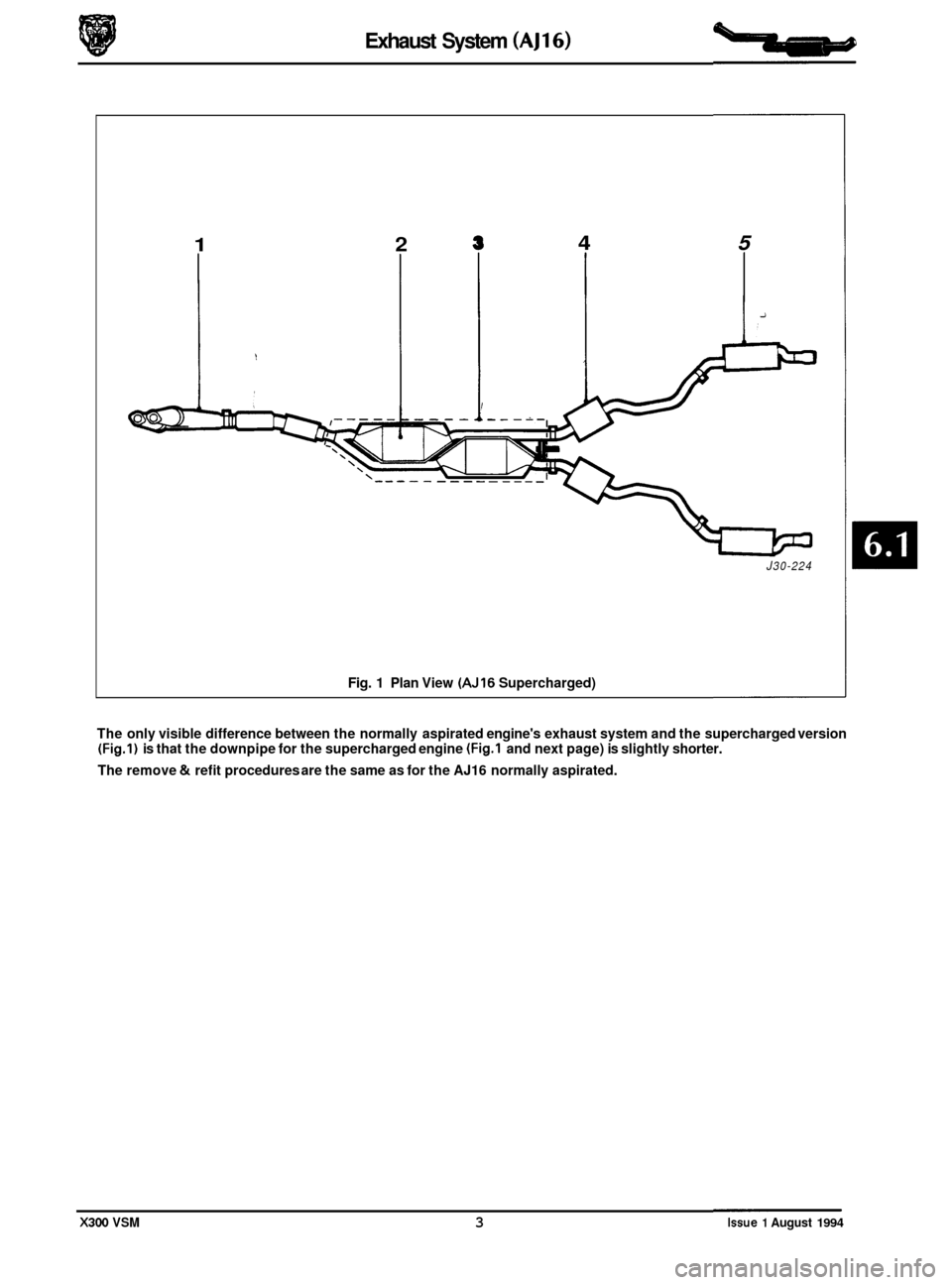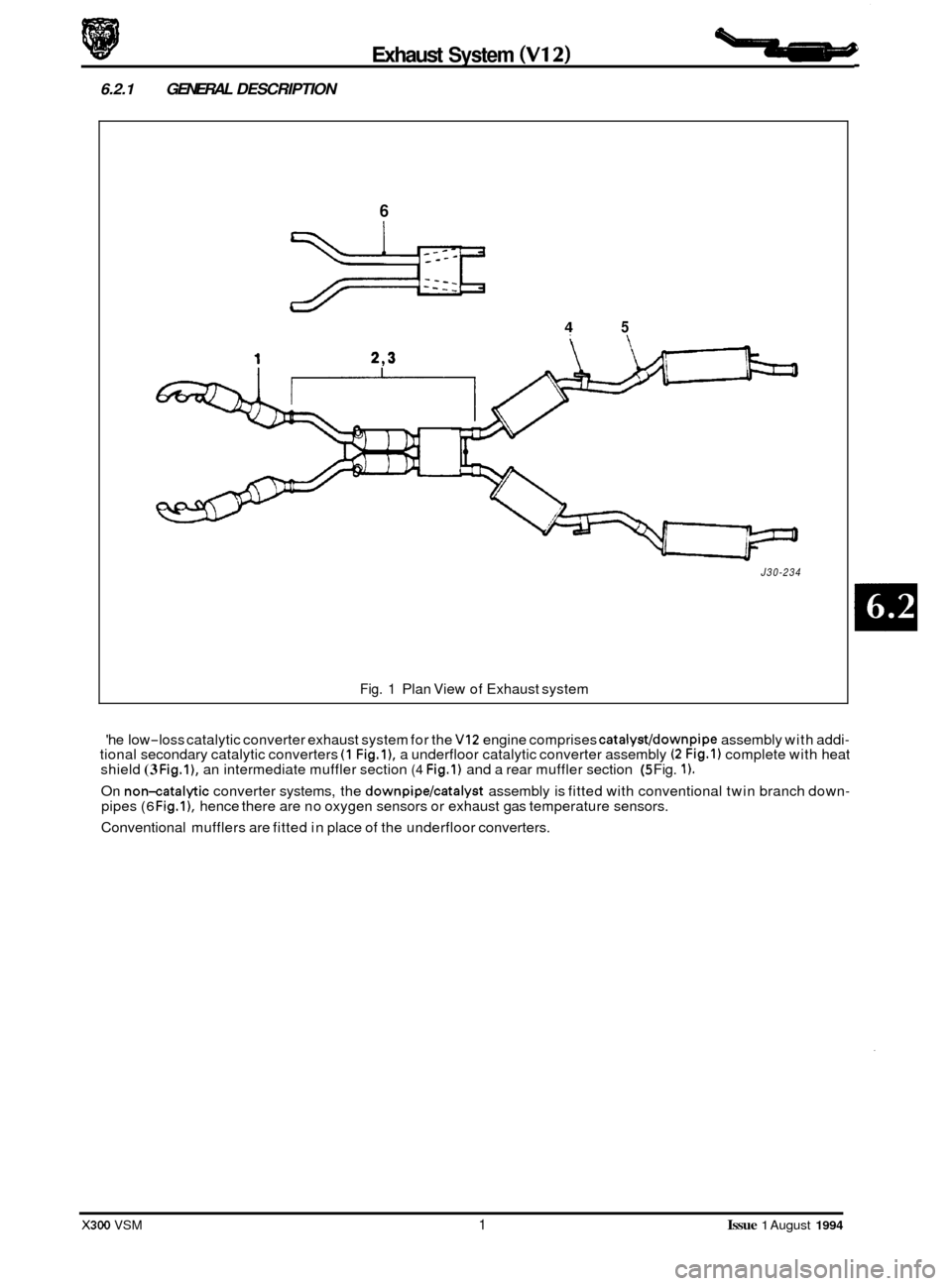JAGUAR XJ6 1994 2.G Workshop Manual
XJ6 1994 2.G
JAGUAR
JAGUAR
https://www.carmanualsonline.info/img/21/7690/w960_7690-0.png
JAGUAR XJ6 1994 2.G Workshop Manual
Trending: battery, wheel, radio, oil capacity, manual transmission, ground clearance, fuse box
Page 101 of 521
Page 102 of 521
1 3 4 S
J30-223
Fig. 1 Plan View, Exhaust System (AJ16 Normally Aspirated)
Page 103 of 521
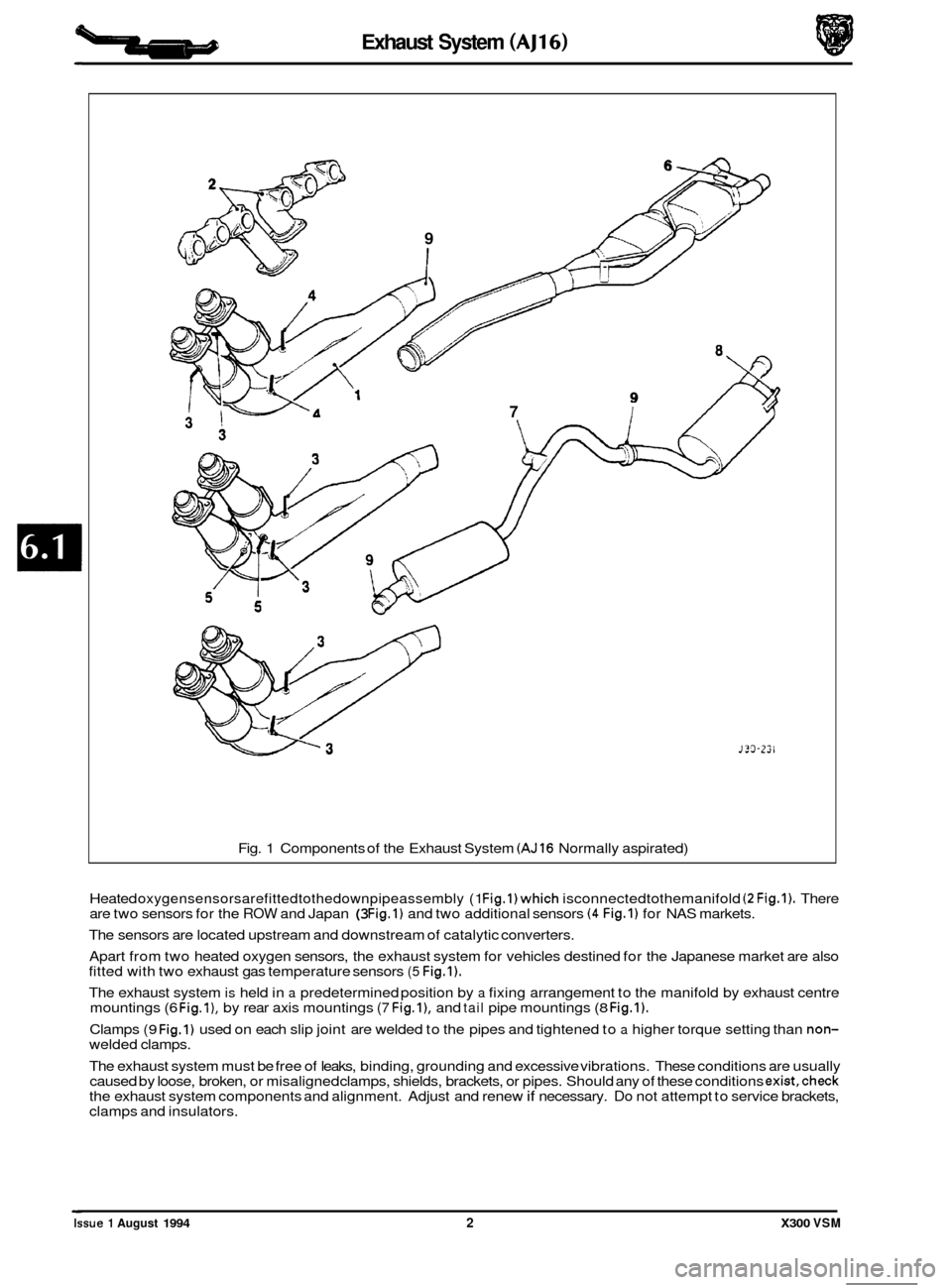
Exhaust System (AJ16)
9
/ 7 I
3;
Fig. 1 Components of the Exhaust System (AJ16 Normally aspirated)
J?3-Z2l
Heated oxygensensorsarefittedtothedownpipeassembly (1 Fig.l)which isconnectedtothemanifold (2 Fig.1). There
are two sensors for the ROW and Japan (3 Fig.1) and two additional sensors (4 Fig.1) for NAS markets.
The sensors are located upstream and downstream of catalytic converters.
Apart from two heated oxygen sensors, the exhaust system for vehicles destined for the Japanese market are also
fitted with two exhaust gas temperature sensors
(5 Fig.1).
The exhaust system is held in a predetermined position by a fixing arrangement to the manifold by exhaust centre
mountings (6 Fig.l), by rear axis mountings (7 Fig.l), and tail pipe mountings (8 Fig.1).
Clamps (9 Fig.1) used on each slip joint are welded to the pipes and tightened to a higher torque setting than non- welded clamps.
The exhaust system must be free of leaks, binding, grounding and excessive vibrations. These conditions are usually
caused by loose, broken, or misaligned clamps, shields, brackets, or pipes. Should any of these conditions
exist,check the exhaust system components and alignment. Adjust and renew if necessary. Do not attempt to service brackets,
clamps and insulators.
Issue 1 August 1994 2 X300 VSM
Page 104 of 521
Exhaust System (AJ16)
1 2
Fig. 1 Plan View (AJ16 Supercharged)
4 5
i
J30-224
The only visible difference between the normally aspirated engine's exhaust system and the supercharged version (Fig.1) is that the downpipe for the supercharged engine (Fig.1 and next page) is slightly shorter.
The remove
& refit procedures are the same as for the AJ16 normally aspirated.
X300 VSM 3 Issue 1 August 1994
Page 105 of 521
W Exhaust System (AJ16)
Fig. 1 Section Layout (AJ16 Supercharged)
0
0
0
0
Issue 1 August 1994 4 X300 VSM
Page 106 of 521
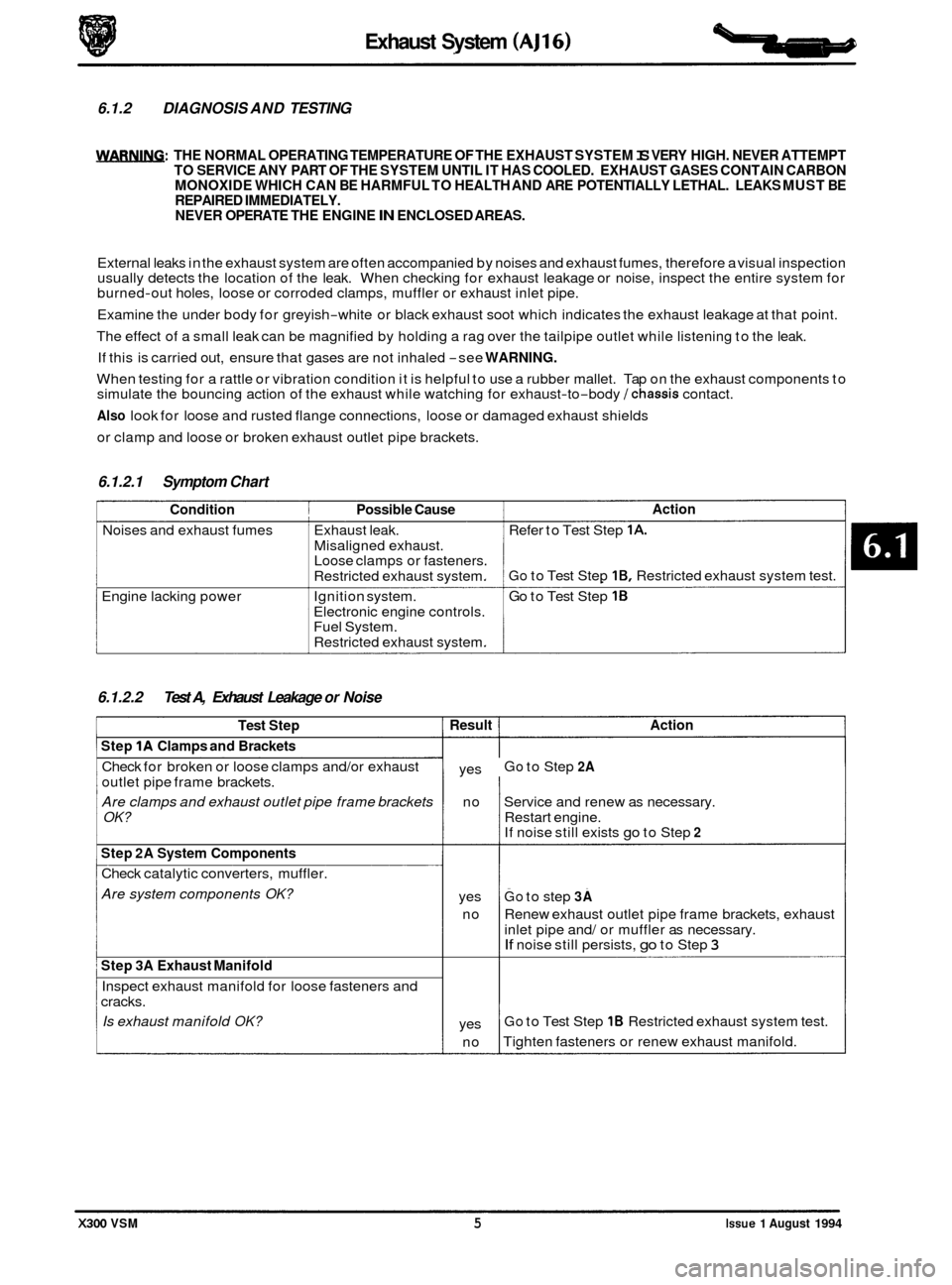
Also look for loose and rusted flange connections, loose or damaged exhaust shields
or clamp and loose or broken exhaust outlet pipe brackets.
6.1.2.1 Symptom Chart
I Condition I Possible Cause
Noises and exhaust fumes Exhaust leak.
Misaligned exhaust.
Loose clamps or fasteners.
Restricted exhaust system.
Electronic engine controls.
Fuel System.
Restricted exhaust system.
Engine lacking
power Ignition system.
Exhaust System (AJ16)
6.1.2 DIAGNOSIS AND TESTING
m: THE NORMAL OPERATING TEMPERATURE OF THE EXHAUST SYSTEM IS VERY HIGH. NEVER ATTEMPT
TO SERVICE ANY PART OF THE SYSTEM UNTIL IT HAS COOLED. EXHAUST GASES CONTAIN CARBON
MONOXIDE WHICH CAN BE HARMFUL TO HEALTH AND ARE POTENTIALLY LETHAL. LEAKS MUST BE
REPAIRED IMMEDIATELY.
NEVER OPERATE THE ENGINE
IN ENCLOSED AREAS.
External leaks in the exhaust system are often accompanied by noises and exhaust fumes, therefore a visual inspection
usually detects the location of the leak. When checking for exhaust leakage or noise, inspect the entire system for
burned
-out holes, loose or corroded clamps, muffler or exhaust inlet pipe.
Examine the under body for greyish
-white or black exhaust soot which indicates the exhaust leakage at that point.
The effect of a small leak can be magnified by holding a rag over the tailpipe outlet while listening to the leak.
If this is carried out, ensure that gases are not inhaled
-see WARNING.
When testing for a rattle or vibration condition it is helpful to use a rubber mallet. Tap on the exhaust components to
simulate the bouncing action of the exhaust while watching for exhaust-to-body /chassis contact.
6.1.2.2 Test A, Exhaust Leakage or Noise
Test Step
Step
1A Clamps and Brackets
Check for broken or loose clamps and/or exhaust
outlet pipe frame brackets.
Are clamps and exhaust outlet pipe frame brackets
OK?
Step 2A System Components
Check catalytic converters, muffler.
Are system components OK?
Step 3A Exhaust Manifold
Inspect exhaust manifold for loose fasteners and
cracks.
Is exhaust manifold OK?
Action
Refer to Test Step 1A.
Go to Test Step IB, Restricted exhaust system test. .-
Go to Test Step 1B
Result Action
yes
1
Go to Step 2A
no Service and renew as necessary.
Restart engine.
If noise still exists
go to Step 2
yes Go to step 3A
no Renew exhaust outlet pipe frame brackets, exhaust
inlet pipe and/ or muffler as necessary.
If noise still persists, go to Step 3
yes
no Go to Test Step 1B Restricted exhaust system test.
Tighten fasteners or renew exhaust manifold.
X300 VSM 5 Issue 1 August 1994
Page 107 of 521
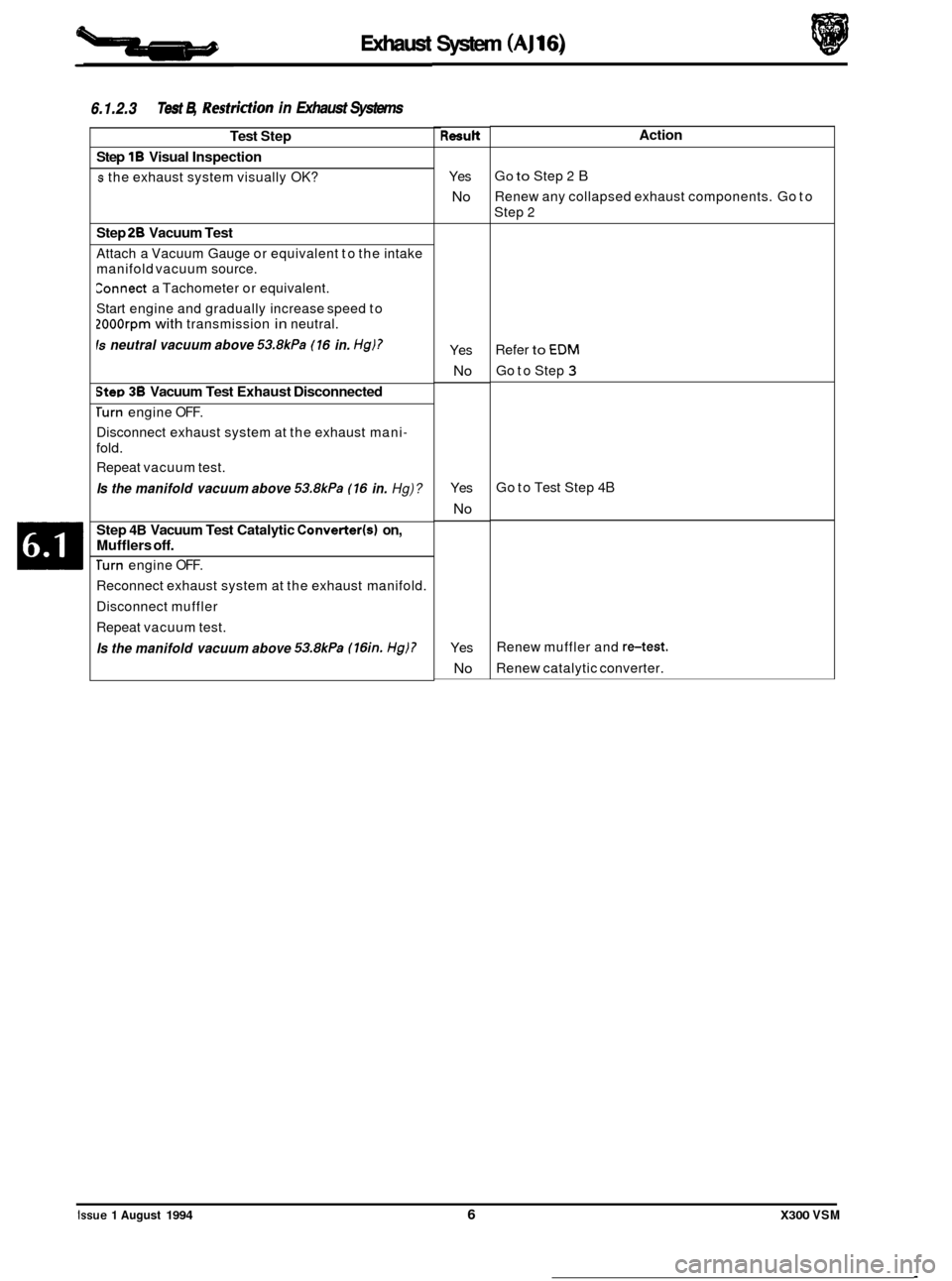
Exhaust
ridion in Exhaust Systems
Test Step
Step
1B Visual Inspection
s the exhaust system visually OK?
Step 28 Vacuum Test
Attach a Vacuum Gauge or equivalent to the intake
manifold vacuum source.
Eonnect a Tachometer or equivalent.
Start engine and gradually increase speed to
2OOOrpm with transmission in neutral.
Is neutral vacuum above 53.8kPa (16 in. Hg)?
Step 38 Vacuum Test Exhaust Disconnected
rurn engine OFF.
Disconnect exhaust system at the exhaust mani-
fold.
Repeat vacuum test.
Is the manifold vacuum above 53.8kPa (16 in. Hg)?
Step 4B Vacuum Test Catalytic Converter(s1 on,
Mufflers off.
+
6.1.2.3 Test B, Rest1
Turn engine OFF.
Reconnect exhaust system at the exhaust manifold.
Disconnect muffler
Repeat vacuum test.
Is the manifold vacuum above 53.8kPa (16in. Hg)?
System (AJ 1 6)
Resutt
Yes
No
Yes
No
Yes
No
Yes
No
Action
Go to Step 2 B
Renew any collapsed exhaust components. Go to
Step
2
Refer to EDM
Go to Step 3
Exhaust System (AJ16)
6.1.2.3 Test B, Restridion in Exhaust Systems
Go to Test Step 4B
Renew muffler and retest.
Renew catalytic converter.
Issue 1 August 1994 6 X300 VSM
Page 108 of 521
Exhaust System (V12) -==mw
SECTION CON TENTS
Subsection Title SRO Page
i ................ Preliminary Page .................................................................... i
6.2.7 .............
6.2.2 ............. Diagnosis& Testing .................................................................. 3
General Description ................................................................. 7
X300 VSM i Issue 1 August 1994
Page 109 of 521
Page 110 of 521
Exhaust System (V12)
6.2.1 GENERAL DESCRIPTION
6
4 5
J30-234
Fig. 1 Plan View of Exhaust system
'he low
-loss catalytic converter exhaust system for the VI2 engine comprises catalyst/downpipe assembly with addi- tional secondary catalytic converters (1 Fig.11, a underfloor catalytic converter assembly (2 Fig.1) complete with heat
shield (3 Fig.l), an intermediate muffler section (4 Fig.1) and a rear muffler section (5 Fig. 1).
On non-catalytic converter systems, the downpipe/catalyst assembly is fitted with conventional twin branch down- pipes (6 Fig.11, hence there are no oxygen sensors or exhaust gas temperature sensors.
Conventional mufflers are fitted in place of the underfloor converters.
X300 VSM 1 Issue 1 August 1994
Trending: bolt pattern, hood release, tire pressure reset, steering, mirror controls, sunroof, wheel size



